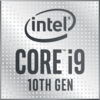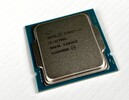Intel Core i9-10850K vs Intel Core i9-11900K vs Intel Core i7-11700K
Intel Core i9-10850K
► remove from comparison
The Intel Core i9-10850K is a high-end processor for desktops with ten cores based on the Comet Lake architecture (CML-S, 4th generation of Skylake). The processor clocks at between 3.6 and 5.2 GHz (all 10 cores up to 4.8 GHz) and can execute up to twenty threads simultaneously thanks to Hyper-Threading. The 5.2 GHz can be only achieved below 70°C core temperature (Thermal Velocity Boost of 100 MHz). Compared to the fastest CML-S CPU, the Core i9-10900K, the 10850K clocks 100 MHz lower (base and Turbo clocks).
The processor is still manufactured in the old 14nm (14nm++) process. Thanks to the free multiplicator, the CPU can also be easily overclocked (but may not have much headroom).
The Comet Lake architecture is similar to Coffee Lake and offers the same features and is produced in the same 14nm process. Other than the improved clock rates, the memory controller now also supports faster DDR4-2933 RAM. More information on Comet Lake and all the models and articles on it can be found here.
Performance
Thanks to the high Turbo Boost, the CPU is a very fast gaming CPU available at the time of announcement. Using all cores, the i9 however is slower than the top Ryzen CPUs (like the Ryzen 9 3950X) which offer more cores.
Graphics
The integrated Intel UHD Graphics 630 iGPU is supposed to offer a similar performance as the UHD630 in the Core i7-9900K. As a low-end solution it will only run current games smoothly at reduced details - if at all.
Power Consumption
Intel specifies the TDP with 125 Watts (PL1) but under full load up to 250 Watt are consumed (PL2). In default mode these 250 Watt and therefore high clock speeds can be maintained for up to 56 seconds, however, all boards offer the option to alter these settings.
Intel Core i9-11900K
► remove from comparison
The Intel Core i9-11900K is a high-end desktop CPU based on the Rocket Lake architecture. The CPU offers 8 cores and 16 threads clocked at 3.5 - 5.3 GHz (Turbo Boost 3.0 / TVB). With Turbo Boost 2.0, 5.1 GHz can be reached with a single thread. Using all cores, the CPU can clock up to 4.8 GHz. Adaptive Boost enables even higher multi-core frequencies (5.1 GHz all core Turbo) but uses a lot more power.
The TDP is rated at 125 Watt (PL1, power limit sustained load) but the PL2 is set to around 250 Watt for short term boosts (up to 56 seconds).
The Sunny Cove processor cores (known from the Ice Lake mobile CPUs) offer larger caches and an improved IPC (up to 19%). Furthermore, the chip also includes (partly) integrated WiFi 6E and Thunderbolt 4. The platform supports PCIe 4.0 and Intel DL Boost for AI acceleration.
The faster Rocket Lake-S CPUs also integrate a new Intel UHD Graphics 750 that is based on the current Intel Xe architecture (e.g. mobile Tiger Lake) and offers 32 EUs. In the 11900K, the GPU is clocked from 350 - 1300 MHz.
Performance
The average 11900K in our database is in the same league as the Ryzen 7 5800X3D, as far as multi-thread benchmark scores are concerned. Which is an impressive result, as of mid 2022, and good enough for any task imaginable including content creation and professional gaming.
Power consumption
This Core i9 has a 125 W TDP, also known as the long-term power limit. Intel lets PC manufacturers reduce that value somewhat if required, 95 W being the lower limit, which would result in lower clock speeds and lower performance. The reality is, an 11900K can be much more power hungry than either of the two numbers imply simply because of its sheer might but also because it is manufactured on an old 14 nm Intel process that makes for lower-than-average, as of mid-2022, energy efficiency.
Intel Core i7-11700K
► remove from comparison
The Intel Core i7-11700K is a high-end desktop CPU based on the Rocket Lake architecture. The CPU offers 8 cores and 16 threads clocked at 3.6 - 4.9 GHz. The TDP is rated at 125 Watt (PL1, power limit sustained load) but the PL2 is set to around 250 Watt for short term boosts (up to 56 seconds).
The Sunny Cove processor cores (known from the Ice Lake mobile CPUs) offer larger caches and an improved IPC (up to 19%). Furthermore, the chip also includes (partly) integrated WiFi 6E and Thunderbolt 4. The platform supports PCIe 4.0 and Intel DL Boost for AI acceleration.
The faster Rocket Lake-S CPUs also integrate a new Intel UHD Graphics 750 that is based on the current Intel Xe architecture (e.g. mobile Tiger Lake).
The CPU is manufactured on an old 14 nm process like the Comet Lake predecessors.
| Model | Intel Core i9-10850K | Intel Core i9-11900K | Intel Core i7-11700K | ||||||||||||||||||||||||||||||||||||||||||||||||||||||||||||||||
| Codename | Comet Lake-S | Rocket Lake | Rocket Lake | ||||||||||||||||||||||||||||||||||||||||||||||||||||||||||||||||
| Series | Intel Comet Lake | Intel Rocket Lake | Intel Rocket Lake | ||||||||||||||||||||||||||||||||||||||||||||||||||||||||||||||||
| Series: Rocket Lake Rocket Lake |
|
|
| ||||||||||||||||||||||||||||||||||||||||||||||||||||||||||||||||
| Clock | 3600 - 5200 MHz | 3500 - 5300 MHz | 3600 - 5000 MHz | ||||||||||||||||||||||||||||||||||||||||||||||||||||||||||||||||
| L1 Cache | 640 KB | 640 KB | 640 KB | ||||||||||||||||||||||||||||||||||||||||||||||||||||||||||||||||
| L2 Cache | 2.5 MB | 4 MB | 4 MB | ||||||||||||||||||||||||||||||||||||||||||||||||||||||||||||||||
| L3 Cache | 20 MB | 16 MB | 16 MB | ||||||||||||||||||||||||||||||||||||||||||||||||||||||||||||||||
| Cores / Threads | 10 / 20 | 8 / 16 | 8 / 16 | ||||||||||||||||||||||||||||||||||||||||||||||||||||||||||||||||
| TDP | 125 Watt | 125 Watt | 125 Watt | ||||||||||||||||||||||||||||||||||||||||||||||||||||||||||||||||
| Technology | 14 nm | 14 nm | 14 nm | ||||||||||||||||||||||||||||||||||||||||||||||||||||||||||||||||
| max. Temp. | 100 °C | 100 °C | 100 °C | ||||||||||||||||||||||||||||||||||||||||||||||||||||||||||||||||
| Socket | 1200 | LGA1200 | LGA1200 | ||||||||||||||||||||||||||||||||||||||||||||||||||||||||||||||||
| Features | TVB, HyperThreading, AVX, AVX2, FMA3, Quick Sync, Virtualization | DDR4-3200 RAM, PCIe 4, 8 GT/s bus, DL Boost, GNA, vPro, MMX, SSE, SSE2, SSE3, SSSE3, SSE4.1, SSE4.2, AES, AVX, AVX2, AVX512F, FMA3, SHA | DDR4-3200 RAM, PCIe 4, 8 GT/s bus, DL Boost, GNA, vPro, MMX, SSE, SSE2, SSE3, SSSE3, SSE4.1, SSE4.2, AVX, AVX2, AVX-512, BMI2, ABM, FMA, ADX, VMX, SMX, SMEP, SMAP, MPX, EIST, TM1, TM2, HT, Turbo, SST, AES-NI, RDRAND, RDSEED, SHA | ||||||||||||||||||||||||||||||||||||||||||||||||||||||||||||||||
| iGPU | Intel UHD Graphics 630 | Intel UHD Graphics Xe 750 32EUs (Rocket Lake) (350 - 1300 MHz) | Intel UHD Graphics Xe 750 32EUs (Rocket Lake) (350 - 1300 MHz) | ||||||||||||||||||||||||||||||||||||||||||||||||||||||||||||||||
| Architecture | x86 | x86 | x86 | ||||||||||||||||||||||||||||||||||||||||||||||||||||||||||||||||
| $453 U.S. | |||||||||||||||||||||||||||||||||||||||||||||||||||||||||||||||||||
| Announced | |||||||||||||||||||||||||||||||||||||||||||||||||||||||||||||||||||
| Manufacturer | ark.intel.com | ark.intel.com |
Benchmarks
Average Benchmarks Intel Core i9-10850K → 100% n=31
Average Benchmarks Intel Core i9-11900K → 104% n=31
Average Benchmarks Intel Core i7-11700K → 94% n=31
* Smaller numbers mean a higher performance
1 This benchmark is not used for the average calculation













